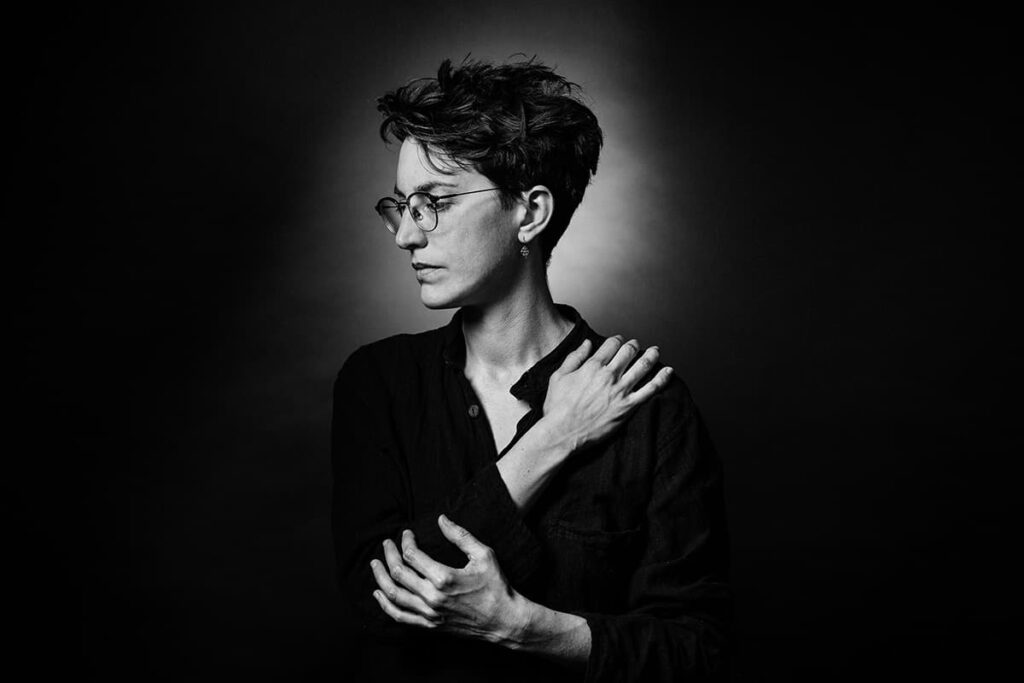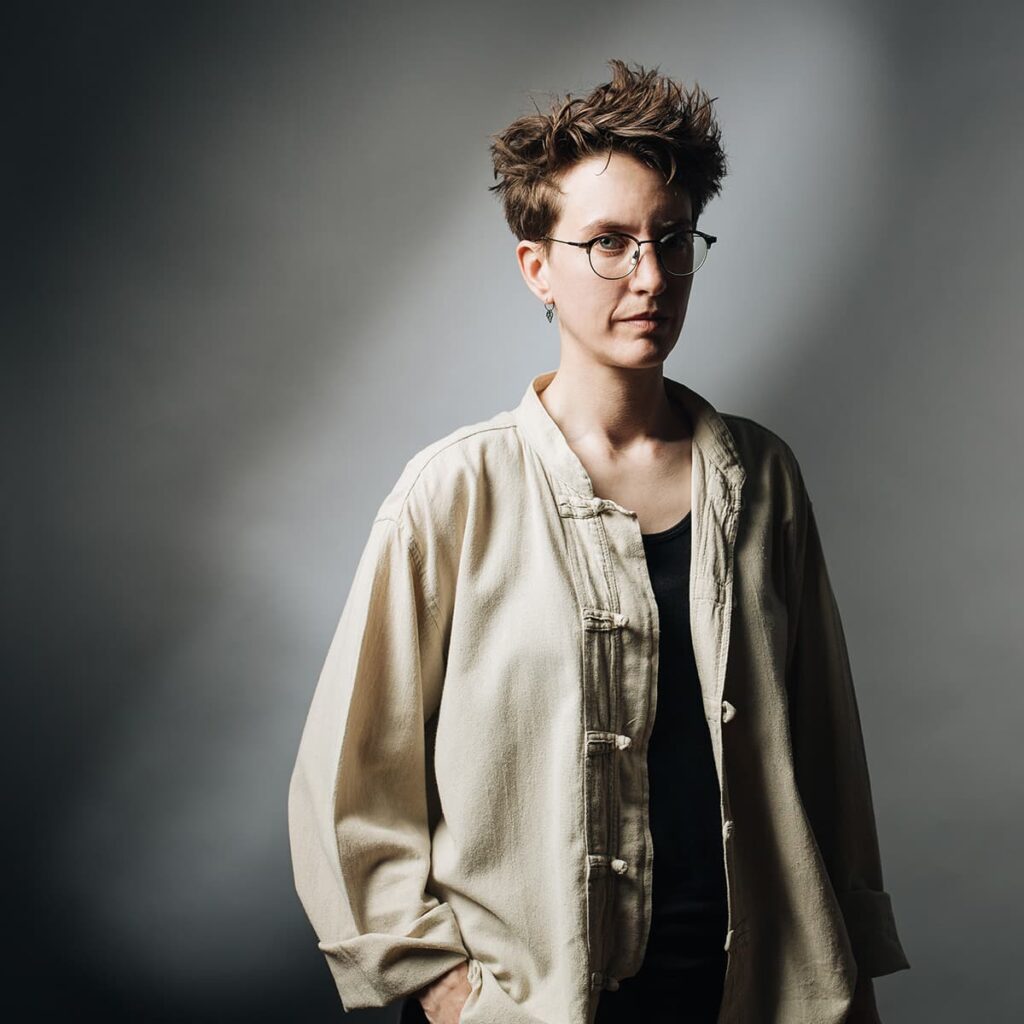
Clara Engel (they, them), a Toronto based artist who has been creating their own music for nearly 20 years. Engel’s work explores areas of neo-avant folk, experimental music, industrial folk, blues as well as whole lot of acoustic sounds drifting constantly beetween all those areas. That organic music is quietly carried away from any genre labels and with an almost cosmic stillness is able to hypnothise and take us in all kind of directions.
They have worked with artists like Thor Harris, Meg Mulhearn, Aidan Baker and many more. Engel boldly explores a more experimental terrain in all kinds of intriguing directions. In the result they break with conventions creating and combining what is known and unknown into their own, small sound sanctuaries.
In mid June the album “Sanguinaria” was released (a review can be found in the latest online Anxious Magazine). We hope it will help you to aquaint with Clara Engel’s music even better.
Artur Mieczkowski
I’m not writing the same song over and over so much as writing one long continuous song that will end when I die.
– Clara Engel
Artur Mieczkowski: You’ve been making records for 20 years now. What made you start making music, when and how did it begin?
Clara Engel: I picked up a guitar when I was eleven or twelve, and I wrote my first song a year or two after that, after I’d heard Bob Dylan and Nirvana. Before that, I wrote poetry and drew. I’ve always been a person who makes things; I don’t remember the beginning.
A.M.: Your new album ‘Sanguinaria’ has recently been released, have you applied any changes in your approach to music making, different solutions, means to create this music?
C.E.: Probably too many to list, and the changes creep in gradually. In 2020 I started recording my songs on my own, at home. That was a big shift for me and I have learned a lot about microphones and recording techniques that I had no idea about before. When I finish an album I never feel satisfied, I just want to do better next time.
A.M.: “Sanguinaria” as a title has an interesting history, what does it mean to you?
C.E.: I wrote a reflection that goes along with the album in which I really explored why I picked the title, but my basic answer is that bloodroot was blooming near my home when I first started working on these songs. Its Latin name is Sanguinaria Canadensis. The flower is a spring ephemeral and blooms for less than a week. I looked it up and read about how the roots are huge and gnarly and bright red when you cut them open. The contrast between the flowers and their roots spoke to me, and relates to my music in the sense that my songs have a certain fragility and openness to them, and people often describe them as ethereal or haunting, but there are weightier and more feral themes if you listen a bit closer.

A.M.: I’m guessing you don’t want to associate yourself with any music genres, and sometimes it’s hard to classify you. Which, by the way, is unnecessary when it comes to perceiving good/real music. However, I am curious to know what inspires you if we are talking about the music itself.
C.E.: I’m happy to associate with many music genres, I just don’t want to be married to any of them. In terms of influence, probably everything I encounter influences me. As a music fan I love exploring, so I can’t give you a comprehensive list of influences — it would either be too long or it would be a gross simplification. So instead, my five most recent Bandcamp purchases were “Primal Prayer” by Beverly Glenn-Copeland, a collection called “Blacklips Bar: Androgyns and Deviants — Industrial Romance for Bruised and Battered Angels,” “Emahoy Tsege Mariam Gebru” (self titled), “Ethiopian Urban Modern Music Vol. 5” by Getatchew Mekuria, and “All of This Is Chance” by Lisa O’Neill. All highly recommended.
A.M.: You have collaborated with Thor Harris (Swans) among others, how do you choose musicians to record together? Is there a concept for the music first or do people turn up and the idea for new material comes from that?
C.E.: Thor Harris played on my album Visitors Are Allowed One Kiss, along with a host of other great players. With that album I gave no directions, I just invited people who knew how to find their way into the songs. Meg Mulhearn, Aidan Baker, Tsinder Ash, Adam Matlock, Dash Lewis, and Armen Ra also added great contributions to that album (and more people – check the album notes on Bandcamp for the full personnel).
A.M.: “We Are Not Here” is the soundtrack to the film. What is it about? How did your collaboration come about?
C.E.: That’s a film by Aaron Mirkin, who is a friend of mine. He created the film, so you should ask him. He was in the studio with me while I improvised the soundtrack, and I did my best to follow his sonic directives. I wrote the closing song “When the Spell Breaks” separately, but other than that the soundtrack was created pretty spontaneously.
A.M.: Have you collaborated on other such projects? Have you created music for theater productions, performances?
C.E.: I would really like to do more projects like that. I wrote a video game soundtrack for a game that never was finished. Also, a dance ensemble in Mexico did a performance based on my song “Microgods of all the Subatomic Worlds” from my album “Songs for Leonora Carrington.” They performed it at the Leonora Carrington Museum, and it was filmed, so you can watch it online.
A.M.: Do you often give concerts? Do you prefer to play concerts alone or with invited musicians?
C.E.: I used to tour fairly often in the US before 2020 but that’s not feasible for me now, for a number of reasons. At my last shows in Toronto I played alone or sometimes with a drummer (Paul Kolinski, he sings and plays banjo and bass drum on the song Deathless on Sanguinaria).
A.M.: Are you also involved in photography? There is a photograph of you on the aforementioned ‘Sanguinaria’.
C.E.: I am not a photographer. I do get the urge to capture certain images when they seem really unusual or beautiful to me though. The image on the cover of Sanguinaria was the only time I’ve ever seen a hare in Toronto. All I had was my old phone camera, so it has a bit of a hazy look, which I like.
A.M.: ‘A New Skin’, for example, features artwork by you. You are a versatile artist. This combination of art from many disciplines surely allows you to create a coherent concept for your musical works?
C.E.: My songs and art all come from the same source, so I guess they naturally have a kind of unified aesthetic. It’s not something that I think about, more something that I observe.
A.M.: Where do you look for inspiration for your lyrics?
C.E.: Life, books, nature, films – I don’t think in terms of inspiration, it’s more about getting to work and sustaining a practice.
A.M.: Social media, streaming have their two faces. How do you perceive this as an independent artist?
C.E.: Social media and streaming have made things very difficult for non-mainstream artists. The internet was an amazing tool for me in its more fledgling phase, back when it was used mostly by people with blogs and specialized interests, and it wasn’t so much about “going viral” and racking up as many streams and “likes” as possible. I have a bleak view of social media at this point.
A.M.: What is the music scene like in Toronto, of course we’re talking about folk music, neo-folk, experimental music etc.?
C.E.: I have no idea really. I’ve never been a part of a scene. The people who buy my music are mainly scattered over Europe and the US.
A.M.: What are your plans for the near future?
C.E.: I’m working on a new EP for the UK label Fenny Compton. I’ve written a handful of new songs on my acoustic guitar, so this might be an unplugged release.
A.M.: Thank you very much for the interview. I wish you the best of luck in pursuing your plans.
C.E.: Thank you.